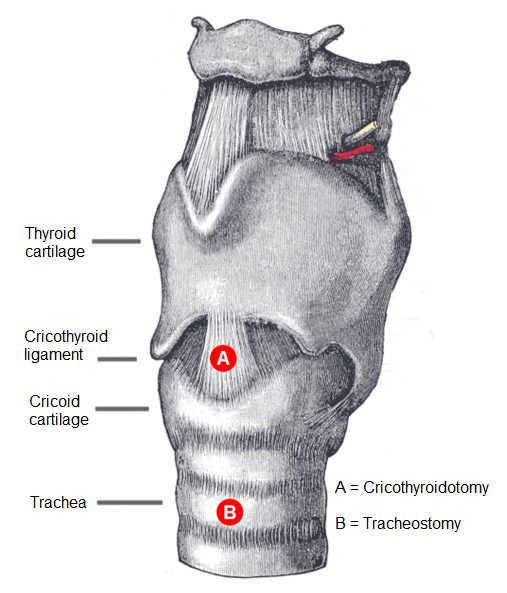.png)
Procedural Skills (SLO6)
A 21 year old woman is brought to ED following a severe allergic reaction. Whilst in ED her lips and tongue continue to swell despite appropriate treatment. The anaesthetic team attempt to perform RSI, but are unable to intubate after several attempts with multiple airways. They are unable to ventilate the patient with a bag-valve mask and the decision is made to proceed to cricothyrotomy. Which of the following landmarks describes the most appropriate location to make the incision?
Answer:
A cricothyrotomy involves making an opening in the median cricothyroid ligament (the medial part of the cricothyroid membrane), between the cricoid cartilage below and the thyroid cartilage above.Surgical Cricothyroidotomy
Procedural Skills (SLO6)
Last Updated: 14th December 2023
Surgical cricothyroidotomy is performed by making a skin incision that extends through the cricothyroid membrane. Surgical cricothyroidotomy provides a definitive airway that can be used to ventilate the lungs until semi-elective intubation or tracheostomy is performed.
Indications
- Can't intubate, can't oxygenate scenario
Advantages vs disadvantages
- Advantages
- Definitive airway
- Enables ventilation and oxygenation until semi-elective intubation or tracheostomy
- Enables suctioning of trachea
- Disadvantages
- Trauma to surrounding structures
- Risk of creating false passage in soft tissues or oesophagus
- Technically more difficult than needle cricothyroidotomy
Procedure
- Extension of the neck will improve surgical access and exposure
- Palpate the thyroid notch, cricothyroid interval, and sternal notch for orientation
- Make a horizontal stab incision through the cricothyroid membrane into the trachea with the scalpel (preferably 20 blade: rounded rather than pointed)
- Open the incision with tracheal dilators or clip (with the scalpel blade still in situ)
- Remove the scalpel blade and insert the intubating bougie into the trachea
- Railroad the tracheal tube (6 or 7 mm cuffed) over the intubating bougie to place it in the trachea
- Inflate the cuff and confirm the tube position
- Secure the tube to the patient to prevent dislodging
Complications
- Aspiration of blood
- Creation of false passage into the tissues
- Subglottic stenosis/oedema
- Laryngeal stenosis
- Oesophageal laceration
- Thyroid laceration
- Haemorrhage or haematoma formation
- Perforation of posterior tracheal wall
- Subcutaneous and/or mediastinal emphysema
- Vocal cord paralysis, hoarseness
Clinical anatomy

Site of Airway Procedures. (Image by By PhilippN [CC-BY-SA-3.0 , via Wikimedia Commons)
Report A Problem
Is there something wrong with this question? Let us know and we’ll fix it as soon as possible.
Loading Form...
- Biochemistry
- Blood Gases
- Haematology
| Biochemistry | Normal Value |
|---|---|
| Sodium | 135 – 145 mmol/l |
| Potassium | 3.0 – 4.5 mmol/l |
| Urea | 2.5 – 7.5 mmol/l |
| Glucose | 3.5 – 5.0 mmol/l |
| Creatinine | 35 – 135 μmol/l |
| Alanine Aminotransferase (ALT) | 5 – 35 U/l |
| Gamma-glutamyl Transferase (GGT) | < 65 U/l |
| Alkaline Phosphatase (ALP) | 30 – 135 U/l |
| Aspartate Aminotransferase (AST) | < 40 U/l |
| Total Protein | 60 – 80 g/l |
| Albumin | 35 – 50 g/l |
| Globulin | 2.4 – 3.5 g/dl |
| Amylase | < 70 U/l |
| Total Bilirubin | 3 – 17 μmol/l |
| Calcium | 2.1 – 2.5 mmol/l |
| Chloride | 95 – 105 mmol/l |
| Phosphate | 0.8 – 1.4 mmol/l |
| Haematology | Normal Value |
|---|---|
| Haemoglobin | 11.5 – 16.6 g/dl |
| White Blood Cells | 4.0 – 11.0 x 109/l |
| Platelets | 150 – 450 x 109/l |
| MCV | 80 – 96 fl |
| MCHC | 32 – 36 g/dl |
| Neutrophils | 2.0 – 7.5 x 109/l |
| Lymphocytes | 1.5 – 4.0 x 109/l |
| Monocytes | 0.3 – 1.0 x 109/l |
| Eosinophils | 0.1 – 0.5 x 109/l |
| Basophils | < 0.2 x 109/l |
| Reticulocytes | < 2% |
| Haematocrit | 0.35 – 0.49 |
| Red Cell Distribution Width | 11 – 15% |
| Blood Gases | Normal Value |
|---|---|
| pH | 7.35 – 7.45 |
| pO2 | 11 – 14 kPa |
| pCO2 | 4.5 – 6.0 kPa |
| Base Excess | -2 – +2 mmol/l |
| Bicarbonate | 24 – 30 mmol/l |
| Lactate | < 2 mmol/l |

